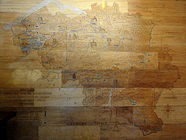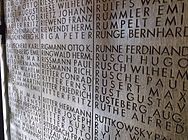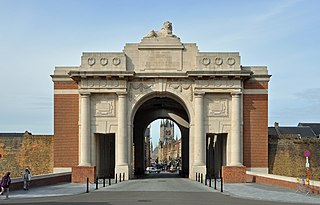
The Menin Gate, officially the Menin Gate Memorial to the Missing, is a war memorial in Ypres, Belgium, dedicated to the British and Commonwealth soldiers who were killed in the Ypres Salient of World War I and whose graves are unknown. The memorial is located at the eastern exit of the town and marks the starting point for one of the main roads that led Allied soldiers to the front line.

La Cambe is a Second World War German military war grave cemetery, located close to the American landing beach of Omaha, and 25.5 km (15.8 mi) north west of Bayeux in Normandy, France. It is the largest German war cemetery in Normandy and contains the remains of over 21,200 German military personnel. Initially, American and German dead were buried in adjacent fields but American dead were later disinterred and either returned to the US or re-interred at the Normandy American Cemetery and Memorial, 15 km (9.3 mi) away. After the war over 12,000 German dead were moved from approximately 1,400 field burials across Normandy to La Cambe. The cemetery is maintained and managed by the voluntary German War Graves Commission.

Vladslo German war cemetery is about three kilometres north east of Vladslo, near Diksmuide, Belgium. Established during World War I, the cemetery originally held 3,233 wartime burials. In 1956, burials from many smaller surrounding cemeteries were concentrated in Vladslo, and it now contains the remains of 25,644 soldiers. Each stone bears the name of twenty soldiers, with just their name, rank, and date of death specified.

A war grave is a burial place for members of the armed forces or civilians who died during military campaigns or operations.

Tyne Cot Commonwealth War Graves Cemetery and Memorial to the Missing is a Commonwealth War Graves Commission (CWGC) burial ground for the dead of World War I in the Ypres Salient on the Western Front. It is the largest cemetery for Commonwealth forces in the world, for any war. The cemetery and its surrounding memorial are located outside Passendale, near Zonnebeke in Belgium.

Henry John Patch, dubbed in his later years "the Last Fighting Tommy", was an English supercentenarian, briefly the oldest man in Europe, and the world's last surviving trench combat soldier of the First World War. Patch was not the longest-surviving soldier of the First World War, but he was the fifth-longest-surviving veteran of any sort from the First World War, behind British veterans Claude Choules and Florence Green, Frank Buckles of the United States and John Babcock of Canada. At the time of his death, aged 111 years and 38 days, Patch was the third-oldest man in the world, behind Walter Breuning and Jiroemon Kimura.
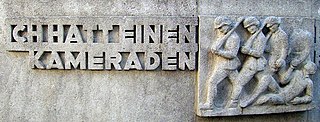
"Der gute Kamerad", also known by its opening line as "Ich hatt' einen Kameraden", is a traditional German anti-war song and soldiers' lament. The lyrics were written by German romantic poet Ludwig Uhland in 1809. Its immediate inspiration was the deployment of Badener troops against the Tyrolean Rebellion. In 1825, the Lieder composer Friedrich Silcher set it to music, based on the tune of a Swiss folk song, in honor of those who fell during the more recent Wars of Liberation against the French Imperial Army of Napoleon Bonaparte.

Ysselsteyn German War Cemetery is a military cemetery interring casualties of the First and Second World Wars. It contains over 31,000 dead from around 25 countries, including Wehrmacht and SS-men and Dutch war criminals. This cemetery is located in the village of Ysselsteyn in the municipality of Venray in Limburg, Netherlands, and is 32 km (20 mi) east of Eindhoven. Ysselsteyn is the largest Second World War German cemetery and is the only Nazi-German cemetery in the Netherlands. Following the war, the Nazi soldiers were reburied in the cemetery. The deceased include Germans, Austrians, Dutch, Poles, Russians and many who fought on the side of Nazi Germany or supported them in non-military roles.

Orglandes War Cemetery is a German World War II cemetery in Normandy, France. It is located on the northern edge of the village of Orglandes, about 30 km (19 mi) south east of Cherbourg and 7 km (4.3 mi) west of Sainte-Mère-Église on the Cotentin Peninsula. The burials come from summer 1944, immediately following D-Day and the Battle of Normandy. It is the second smallest of the six German war cemeteries in Normandy with a little over 10,000 burials. The cemetery is maintained and managed by the voluntary German War Graves Commission.
The German War Graves Commission is responsible for the maintenance and upkeep of German war graves in Europe and North Africa. Its objectives are acquisition, maintenance and care of German war graves; tending to next of kin; youth and educational work; and preservation of the memory to the sacrifices of war and despotism. Former head of the Bundeswehr Wolfgang Schneiderhan was elected President of the organisation in 2016, succeeding SPD politician Markus Meckel. The President of Germany, currently Frank-Walter Steinmeier (SPD), is the organisation's patron.
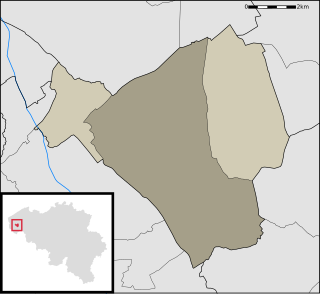
Langemark is a village in the Belgian province of West Flanders, and a subdivision of the municipality of Langemark-Poelkapelle. The village has about 5,000 inhabitants. Besides the village center, there are also three smaller hamlets on the territory, Madonna, Bikschote and Saint-Julien/Sint-Juliaan.

The Sandweiler German war cemetery is a World War II cemetery in Sandweiler, in southern Luxembourg. It contains the graves of 10,913 German servicemen from the Battle of the Bulge in winter 1944 and spring 1945. Of these, 5,599 were buried by the American war graves service during the war; American casualties were buried at the Luxembourg American Cemetery and Memorial about 1.5 kilometres (0.93 mi) away in Hamm.

The St Symphorien Military Cemetery is a First World War Commonwealth War Graves Commission burial ground in Saint-Symphorien, Belgium. It contains the graves of 284 German and 229 Commonwealth soldiers, principally those killed during the Battle of Mons. The cemetery was established by the German Army on land donated by Jean Houzeau de Lehaie. It was initially designed as a woodland cemetery before being redesigned by William Harrison Cowlishaw after the Imperial War Graves Commission took over maintenance of the cemetery after the war.

The Menen German war cemetery is a military cemetery in the Belgian town of Menen territory and partly in Wevelgem. There were nearly 48,000 German soldiers buried from the First World War, making it the largest in Flanders. In between are several crosses and oak and chestnut trees. In the center is an octagonal memorial chapel.
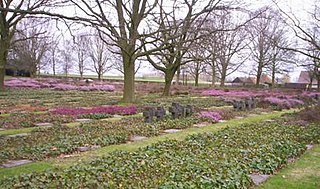
The Hooglede German war cemetery is a military cemetery in the Belgian town of Hooglede, six kilometer northwest of Roeselare. It is located at the east side of Hooglede. It contains 8,241 buried German soldiers from World War I.

Sologubovka Cemetery is a German war cemetery and the final resting place of over 30,000 German war dead from World War II. Located 70 kilometres (43 mi) southeast of St. Petersburg in northwestern Russia, it has a capacity for a further 50,000 burials of previously lost German war dead.

Recogne German war cemetery is located in the hamlet of Recogne near the municipality of Bastogne, Belgium. It contains the graves of 6,807 German soldiers of the Second World War. The cemetery is situated to the east of the hamlet, and to the south of the road to Foy. It is maintained by the German War Graves Commission.

Champigny-Saint-André is a German World War II cemetery in Normandy, France. It is located 5 kilometers South of the village of Saint-André-de-l'Eure, about 25 km (16 mi) south east of Évreux. The burials come from the summer of 1944, as the Allies pushed out of Normandy towards Paris. It is the second largest of the six German war cemeteries in Normandy with a nearly 20,000 burials. The cemetery is maintained and managed by the voluntary German War Graves Commission.

Mont-de-Huisnes German war cemetery is a military war grave mausoleum, located 1 km north of Huisnes-sur-Mer and a few kilometres southwest of Avranches, France. It presently contains in nearly 12,000 burials of German military personnel of World War II, plus some women and children. It is maintained and managed by the German War Graves Commission.
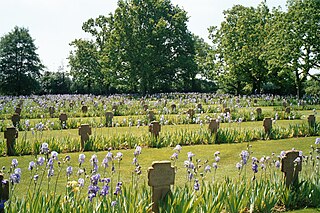
Saint-Désir-de-Lisieux is a Second World War German military war grave cemetery, located close to the village of Saint-Désir and 4 km (2.5 mi) west of Lisieux in the Calvados department, Normandy, France. It is located adjacent to the British Saint-Désir War Cemetery and is unique as the two burial grounds are linked by a pathway. It is the smallest German war cemetery in Normandy and contains the remains of 3,735 German military personnel. The cemetery was created by the British Graves Registration Commission in August 1944 with British and German casualties buried in adjacent fields.



